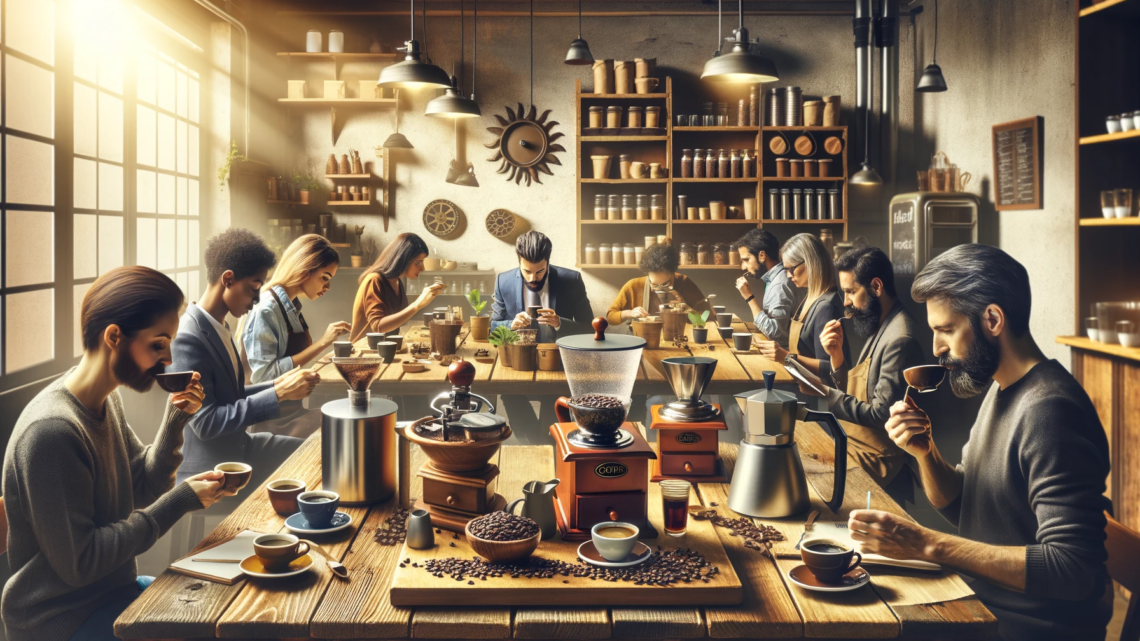The Intricate World of Coffee Tasting for Beginners
The morning cup of coffee is a ritual cherished by millions, a familiar comfort signaling the start of a new day. But beyond this daily routine lies a vast, nuanced world that transforms coffee from a mere beverage into an art form. This world is that of coffee tasting, a realm where each sip tells a story, each aroma unveils a secret. For those willing to delve deeper, coffee tasting opens doors to a sensory adventure rich in history, culture, and flavor.
Coffee tasting, also known as ‘cupping’, is more than a practice; it’s an experience that has evolved over centuries. Originating in coffee-growing regions as a means to assess quality, it has blossomed into a sophisticated ritual practiced by connoisseurs and enthusiasts globally. This article aims to guide you through the intricate process of coffee tasting, unraveling its mysteries and showcasing the depths of what a cup of coffee can offer.
For the uninitiated, the concept of coffee tasting might seem daunting or reserved for professionals. However, this is far from the truth. Just like wine tasting, coffee tasting is accessible to anyone eager to explore and learn. It’s an invitation to slow down, to savor, to truly engage with the complexities of coffee flavors and aromas. Whether you’re a seasoned coffee drinker or a curious newcomer, understanding the subtleties of coffee can transform your appreciation for this beloved beverage.
In this article, we will journey through the essentials of coffee tasting. From the history and evolution of cupping to the practical steps of conducting your own tasting session, we aim to provide a thorough exploration of this fascinating aspect of coffee culture. Prepare to embark on a flavorful voyage that will deepen your love and understanding of coffee, taking you from a casual drinker to an informed enthusiast, one cup at a time.
The Essence of Coffee Tasting
Origins and Evolution:
Coffee tasting, often termed ‘cupping’, traces its roots back to coffee-producing regions, where it was initially used as a method to evaluate the quality of coffee beans. Historically, traders and producers would sample different batches of coffee to determine their flavor profiles and suitability for sale. Over time, this practice evolved into a sophisticated art form, embraced by coffee enthusiasts worldwide. Today, cupping is not only a critical step in the coffee production process but also a popular activity among coffee lovers who seek to deepen their understanding and appreciation of their favorite beverage.
Modern Coffee Tasting:
In the contemporary coffee scene, cupping serves a dual purpose. For professionals, it remains an essential tool for assessing coffee quality, ensuring consistency, and identifying distinct characteristics of different coffee varieties. For casual enthusiasts, it’s an avenue to explore the diverse world of coffee flavors. Modern cupping sessions often involve a ritualistic approach, focusing on the sensory experiences – visual inspection of beans, smelling the ground coffee, and, most importantly, tasting. The tasting process is where the magic happens, revealing notes ranging from fruity and floral to earthy and nutty.
The Basics of Coffee Cupping
Equipment and Setup:
For a basic cupping session, the essential tools include fresh coffee beans, a reliable grinder, hot water at the right temperature (about 200°F or 93°C), a spoon, and a cupping bowl. The size and shape of the bowl can influence the tasting experience, with wider bowls allowing for better aroma evaluation.
Cupping Process:
The process begins with smelling the freshly ground coffee, noting the initial aromas. Hot water is then poured over the grounds, and the coffee is allowed to steep for about 4 minutes. A crucial part of cupping is breaking the crust formed by the coffee grounds on the surface, which releases a burst of aroma. This is followed by the actual tasting, where you slurp the coffee to aerate it and spread it evenly across the palate. This slurping action is vital as it helps to perceive the full range of flavors. Participants assess the coffee’s body (texture), acidity (sharpness), and aftertaste, among other characteristics.
Preparing for Your First Coffee Tasting Session
Creating the Right Environment:
An ideal coffee tasting environment is quiet and free from strong odors that could interfere with the sensory experience. Natural light is preferable, and the temperature should be comfortable. It’s also important to use neutral water (pH 7) to ensure it doesn’t alter the coffee’s flavor.
Selecting Coffee:
Choosing the right coffee is crucial. For beginners, it’s recommended to start with single-origin coffees to understand the distinct flavors of different regions. The beans should be freshly roasted, ideally within the past week, and ground just before brewing to preserve their aromatics.
Reference to ECoffeeFinder’s Toolkit:
The “Coffee Taster’s Toolkit Handbook” available on ECoffeeFinder provides an excellent resource for beginners, offering detailed guidance on how to conduct a tasting session, including choosing the right beans, understanding flavor notes, and recording observations.
Coffee Tasting Terminology
| Term | Definition |
|---|---|
| Acidity | Refers to the bright, tangy, or sharp taste; often described as ‘liveliness’ or ‘brightness’. |
| Body | The physical mouthfeel of the coffee; can range from light and delicate to thick and full-bodied. |
| Aroma | The smell of the coffee, which can include a variety of scents from floral to spicy. |
| Flavor | The overall perception of aroma, acidity, and body; the main characteristics of the coffee. |
| Aftertaste | The lingering taste left in the mouth after swallowing the coffee. |
Identifying Coffee Flavors and Aromas
Flavor Profile Basics:
One of the key aspects of coffee tasting is learning to identify various flavors and aromas. Coffee can have a wide range of flavors, from fruity and floral to spicy and nutty. These flavors are influenced by the coffee’s origin, processing method, and roast level. A good starting point for beginners is to familiarize themselves with the Coffee Flavor Wheel, a tool used by professionals to describe and categorize coffee flavors and aromas accurately.
Developing Your Palate:
Developing a refined palate for coffee tasting doesn’t happen overnight. It involves regular tasting and practice. Beginners should start by tasting different types of coffee and paying close attention to the nuances in flavor and aroma. Keeping a tasting journal can be helpful for tracking and understanding personal preferences and the subtle differences between various coffees.
The Art of Slurping
Why Slurping Matters:
Slurping might seem unusual or even impolite in some contexts, but in coffee cupping, it’s essential. Slurping vigorously aerates the coffee, spreading it across the palate and allowing the taster to experience the full range of flavors and aromas. It also helps to cool the coffee, reducing the risk of burning your tongue.
Technique:
To slurp effectively, take a spoonful of coffee and inhale it sharply into your mouth, ensuring it sprays across the entire palate. This action helps to engage all taste receptors, providing a comprehensive tasting experience. Practice is key to mastering this technique without splashing or coughing.
Exploring the Diversity of Coffee Origins and Varieties
Regional Characteristics and Their Impact:
Coffee beans are profoundly influenced by their terroir, a term that encompasses the geography, climate, and soil in which they are grown. This influence is reflected in the distinct flavor profiles associated with different coffee-producing regions:
- African Coffees: Often characterized by their bright acidity and complex fruit and floral notes, African coffees, especially those from Ethiopia and Kenya, are renowned for their unique flavors. Ethiopian coffees, for example, can exhibit a wide range of flavors, from winey and berry-like to floral and tea-like, depending on the region and processing method.
- Latin American Coffees: Coffees from Central and South America, like those from Colombia and Brazil, typically exhibit a balanced, mild flavor profile. They often have pronounced nutty, chocolatey, or caramel notes, making them favorites among a broad audience. Colombian coffees, for instance, are known for their smooth, mild flavor and balanced acidity, often with hints of nuts and fruits.
- Asian Coffees: Asia, particularly regions like Sumatra and Java in Indonesia, produces coffees known for their full body and low acidity. Indonesian coffees are often rich and earthy, with deep, complex flavor profiles that can include notes of spices, chocolate, and dark fruits.
Coffee Regions and Flavor Profiles
| Region | Typical Flavor Characteristics |
|---|---|
| Africa | Fruity, floral, wine-like acidity, berry notes. |
| Latin America | Nutty, chocolatey, balanced sweetness and acidity. |
| Asia | Full-bodied, earthy, spicy, lower acidity. |
| Pacific | Tropical, spicy, full-bodied, often earthy undertones. |
Varietal Differences and Their Taste Profiles:
Coffee varieties also play a crucial role in the flavor of the brew. While there are numerous coffee varieties, the two most commercially significant are Arabica and Robusta:
- Arabica: Known for its smooth, often complex flavor and lower caffeine content, Arabica is the more widely consumed of the two. It’s typically grown at higher altitudes, which contributes to its flavor complexity. Arabica beans are prized for their diverse flavor profiles, ranging from sweet and fruity to floral and tangy.
- Robusta: Robusta beans have a stronger, more bitter flavor with a higher caffeine content. They are often described as having a more earthy, woody taste and are generally used in espresso blends for their rich crema and body. Robusta is more resistant to pests and diseases and is grown at lower altitudes.
Link to ECoffeeFinder’s Article:
For further exploration into the world of coffee varieties and their unique characteristics, ECoffeeFinder’s article “Mastering the Art of Coffee Tasting” offers a comprehensive guide. It delves deeper into the subtleties of different coffee regions, providing valuable insights for both beginners and seasoned coffee enthusiasts.
Hosting a Coffee Tasting Party
Planning and Preparation:
Hosting a coffee tasting party is an excellent way to share your passion for coffee with friends and family. Start by selecting a diverse range of coffee beans, ideally from various regions and different roast levels, to showcase a wide spectrum of flavors. Ensure you have enough cupping equipment, like bowls, spoons, and cups, for all participants.
Creating a Tasting Menu:
Design a tasting menu that guides your guests through the different coffees, starting from lighter roasts and moving towards darker ones. Include a brief description of each coffee, highlighting its origin, variety, and expected flavor notes. This not only educates your guests but also enhances their tasting experience.
Coffee Cupping Steps
| Step | Description |
|---|---|
| 1. Smell the Grounds | Assess the aroma of the fresh coffee grounds before brewing. |
| 2. Pour Hot Water | Pour hot water over the grounds and let it steep. |
| 3. Break the Crust | Gently stir the crust that forms to release the aroma. |
| 4. Slurp | Vigorously slurp the coffee to aerate it and spread it over your palate. |
| 5. Evaluate | Consider the body, acidity, flavor, and aftertaste of the coffee. |
Guiding the Tasting Session:
As the host, guide your guests through the cupping process. Demonstrate how to smell, slurp, and savor the coffee, explaining what to look for in terms of aroma, flavor, body, and acidity. Encourage open discussion about each coffee’s characteristics and personal taste preferences. It’s important to create a relaxed and inclusive atmosphere where everyone feels comfortable sharing their thoughts.
Coffee Tasting Etiquette and Best Practices
Cupping Protocol:
Proper etiquette is essential during a formal coffee cupping session. This includes avoiding wearing strong perfumes or lotions, as they can interfere with the aroma of the coffee. Participants should also refrain from talking during the initial smelling and tasting phases to allow for individual concentration and assessment.
Best Practices:
Always start with a clean palate; avoid eating strongly flavored foods before the session. Use clean, hot water, and ensure all cupping equipment is odor-free and neutral. Consistency in the cupping process, like using the same water temperature and coffee-to-water ratio for each sample, is crucial for a fair evaluation.
Advanced Coffee Tasting Techniques
Beyond the Basics:
For those looking to deepen their coffee tasting skills, exploring advanced techniques is the next step. This includes learning to identify subtle differences in acidity, body, sweetness, and aftertaste. Understanding these elements can help in discerning the quality and complexity of the coffee.
Experimenting with Brewing Methods:
Different brewing methods can extract varied flavor profiles from the same coffee. Experiment with methods like the French press, pour-over, and espresso to see how they alter the taste. This not only broadens your tasting experience but also provides insights into how brewing variables affect the final cup.

Expanding Your Coffee Tasting Journey
Further Learning:
The journey into coffee tasting is continuous. Engage with local coffee communities, attend cupping sessions at cafes or roasteries, and participate in workshops and seminars. These activities offer opportunities to learn from experienced professionals and fellow enthusiasts.
Exploring New Coffees:
Regularly trying new coffees from different regions and roasters is essential for expanding your palate. Subscription services or coffee clubs can be a convenient way to explore a variety of coffees. Keeping an open mind and a curious palate is key to discovering new favorites and deepening your appreciation for coffee.
A Journey Through the World of Coffee Tasting
As we conclude this journey into the art of coffee tasting, it’s clear that this practice offers much more than just the ability to distinguish good coffee from great. It’s a pathway to a deeper appreciation of the craft behind each cup, an understanding of the diverse global coffee culture, and a means to connect with fellow coffee enthusiasts. Whether you’re just starting out or are a seasoned taster, the world of coffee tasting is endlessly rich and rewarding. Keep exploring, tasting, and learning, and let your coffee journey continue to evolve.
FAQ Section
1. What is a coffee tasting called?
Coffee tasting is often referred to as ‘coffee cupping.’ It’s a standardized method used by coffee professionals and enthusiasts to evaluate and compare the aroma and flavor profiles of different coffee beans.
2. What is the point of coffee tasting?
The primary purpose of coffee tasting is to assess and appreciate the quality, flavor complexity, and unique characteristics of coffee beans. It helps in understanding the impact of different growing regions, processing methods, and roasting styles on the taste of the coffee.
3. Can you do a coffee tasting?
Absolutely! Anyone can conduct a coffee tasting. It requires some basic equipment like fresh coffee, a grinder, hot water, a spoon, and a cup. Beginners can start with basic techniques and gradually explore more advanced aspects of coffee tasting.
4. What is a coffee tasting session?
A coffee tasting session, or cupping session, is an organized event where participants sample and evaluate a variety of coffees. It involves a systematic process of smelling the ground coffee, assessing the aroma after hot water is added, and then tasting the coffee to analyze its flavor profile, body, and acidity.
Join the Conversation and Enhance Your Coffee Journey
We hope this journey into the art of coffee tasting has sparked your curiosity and enriched your coffee experience. Now, we’d love to hear from you! Drop a comment below and share your favorite coffee experiences. What unique flavors have you discovered? Have you tried coffee cupping at home or in a café? Your stories and insights are what make the coffee community vibrant and diverse.
But don’t stop there — take your coffee tasting to the next level! Grab a copy of the Coffee Taster’s Toolkit Handbook. This comprehensive guide is an invaluable resource for both beginners and seasoned tasters. It’s filled with coffee tasting sheets, tips, and techniques that will transform the way you enjoy coffee.
#Sponsored

Check it out here: The Coffee Taster’s Toolkit Handbook.
Whether you’re just starting out or you’re a seasoned coffee aficionado, there’s always more to learn and taste in the world of coffee. So, share your story, continue your exploration, and keep savoring every cup!

